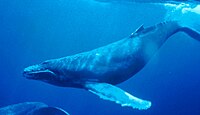
Photo from wikipedia
Catchment land-use intensification and conversion of native vegetation to farmland threatens aquatic ecosystems worldwide by increasing exports of nutrients and fine sediment into streams, rivers and estuaries, resulting in a… Click to show full abstract
Catchment land-use intensification and conversion of native vegetation to farmland threatens aquatic ecosystems worldwide by increasing exports of nutrients and fine sediment into streams, rivers and estuaries, resulting in a decline of aquatic biodiversity and ecosystem health. Using a survey approach, we studied the effects of catchment land-use intensity on benthic invertebrate communities along a freshwater-marine gradient in 21 New Zealand rivers and their estuaries, encompassing a broad range of catchment land-use intensities. Traditional community metrics such as total invertebrate abundance and taxonomic richness decreased from freshwater sites to near-marine sites, but did not perform as well as biological traits when detecting catchment land-use effects along the freshwater-marine continuum. Three trait categories were directly related to the gradient of catchment development while 11 trait categories responded to increasing deposited fine sediment levels which, in turn, were positively related to catchment development. The direction of the response varied for the different biological traits along the gradient. Only one trait category (medium body size) was negatively related to nutrients (dissolved inorganic nitrogen). Importantly, the effects of catchment development did not decrease toward the ocean for any of the response variables studied, indicating no dilution effect due to an increasing marine influence. Consequently, aquatic resource managers need to consider the entire source-to-sea continuum when making decisions to avoid or minimize adverse effects of human land-use activities such as intensive agriculture on freshwater, estuarine, and coastal marine habitats.
Journal Title: Limnology and Oceanography
Year Published: 2017
Link to full text (if available)
Share on Social Media: Sign Up to like & get
recommendations!